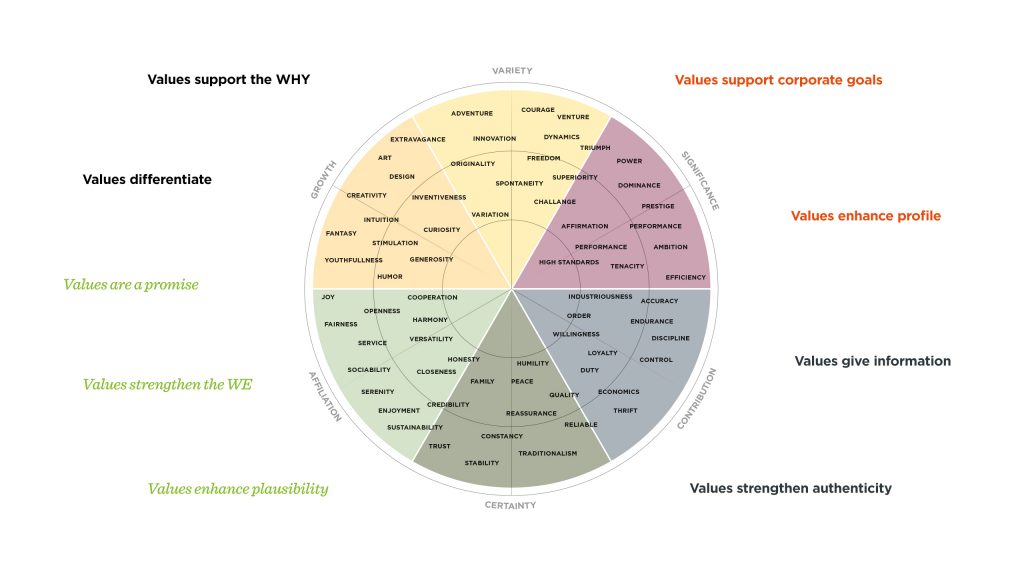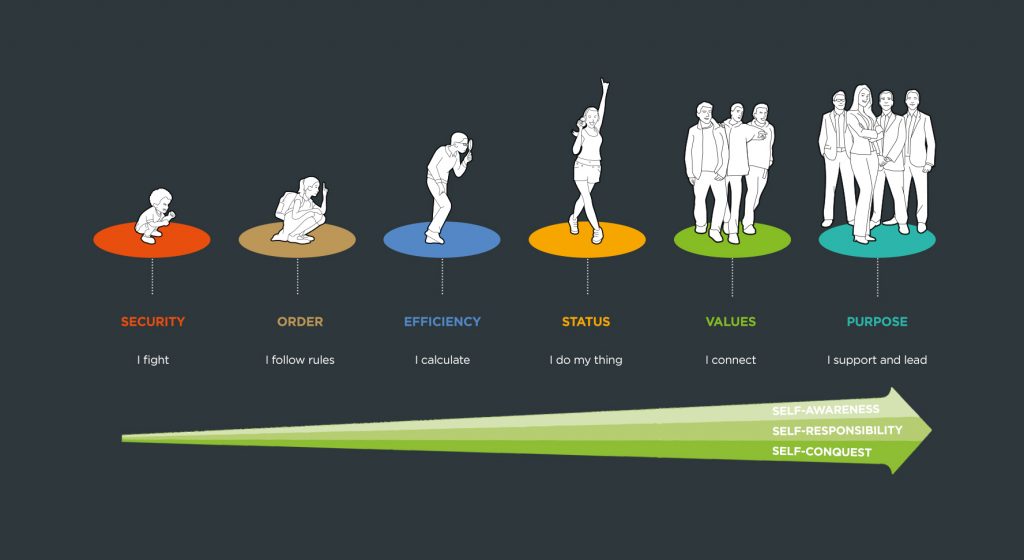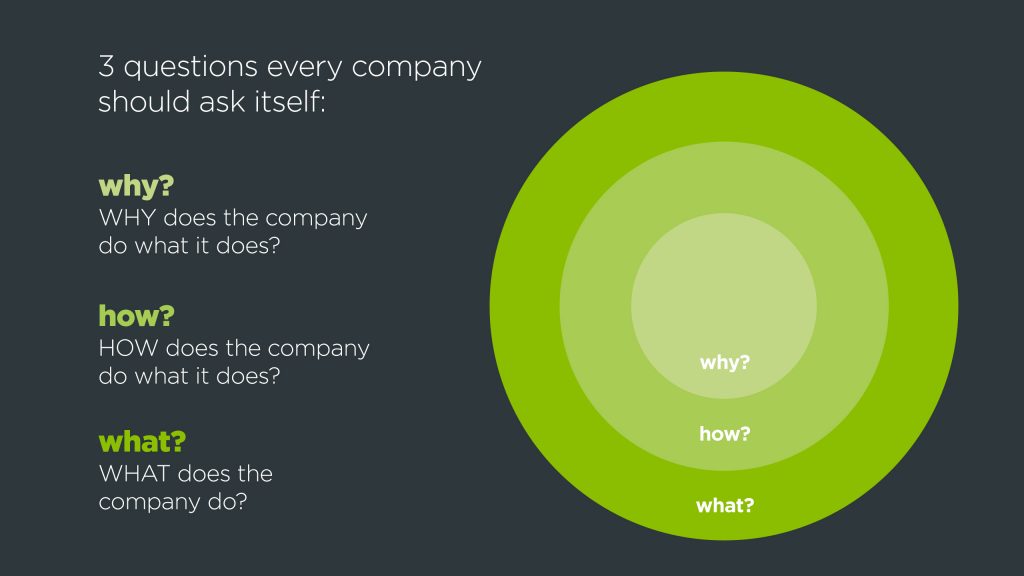What impact do corporate leadership and culture have on the success of digital collaboration?
What makes teamwork work?
Let’s start with the conditions required for successful teamwork. Simon Sinek sums it up like this:
“A team is not a group of people who work together.
A team is a group of people who trust each other.”
This is even truer with digital teamwork than with working in an environment where everybody is present. Establishing trust is complicated. I would like to single out three features that are essential to this process:
- Knowing that you work for a company that doesn’t just proclaim values but actually lives them. And that these values agree with your personal values.
- A certain level of personal development. On the one hand, in managers who are trustworthy and inspire trust in others. This requires a mindset that goes beyond just “command & control”. And on the other, in employees who have organised themselves sufficiently well to collaborate effectively in digital teams. (Not to mention the necessary skills & technology).
- A shared sense of purpose, which makes us feel that everyone is pulling together and working for a common goal, even though we might do it differently.
It might sound a bit anachronistic, but values, mindset and purpose are what matters. They capture the very essence of who we are and what we do.
How does a company get there? Before I address the topic of values and mindset, first a summary.
- Identify and visualise shared core values.
There are a number of options here. We have had positive experience with our scientifically founded and practical Values Development method (in German). We use it to expose, discuss and communicate the values.
- Reflect on your own mindset.
Visualisation can be a great help here – our six mindset model leads to interesting “lightbulb” moments, starts a conversation and stimulates motivation.
- People want to work with purpose.
This sense of purpose in often no longer present in companies that have been around for a while. If you want to learn the “why” of a company, it’s a good idea to ask managers and employees to share their company stories. This helps shed light on the values that are actually lived and shared. Purpose connects everyone in the company, irrespective of their role.
There are 3 questions every organisation should ask: What does the company do? How does the company do what it does? Why does the company do what it does?
Now to go into detail!
Practiced values provide orientation
Shared values are an absolute must if collaboration is to succeed.
However, managers lose credibility when they merely proclaim values but don’t live up to them. This phenomenon is well known. Values only have an impact if they really are lived, whether in a corporate culture – especially by managers who serve as role models – or in society as a whole.
Our values test therefore also covers the intuitive arena. This enables companies to determine whether they already practise the culture they preach, from employee to manager and back again. If this is the case, they can use their corporate culture strategically – to develop their leadership culture, communicate their brand positioning and build a stronger employer brand.
Our values target elucidates the results of the values test. This creates transparency and facilitates communication: staff and managers at all levels can exchange their different perceptions. We can then target development of leadership and corporate cultures.
Whether in a company or in society, values only have real merit when they influence how people really behave in practice and not in theory.
Update May 2020: Our values target is now available a s a poster. Free of charge and with instructions! This will give you an initial idea of our method.
Long live self-reflection!
Getting to know your own mindset is the next important step for everyone in the company.
It’s a matter of expanding the scope for action, for personal development is essential for the development of team and organisation. This is particularly important in management development. To help the self-reflection process we have put together 12 sentence stems which you can complete any way you like. Just give it a try!
The topic of mindsets is not about the umpteenth “change” in the conventional sense, but the evolutionary development of the leadership style and the corporate culture. It therefore always concerns the next step from a given starting point. To begin with we need an emotional reference experience for the next mindset, which then needs to be practised and consolidated. Only then can we move on to the next mindset. How long this takes depends on your own state of mind and the framework conditions.
Each mindset encompasses the ones that precede it. In critical situations we often backslide one or two mindsets. It’s important to find our way back to the mindset we prefer.
Our six mindset model draws on the scientific findings of the ego development theory proposed by Jane Loevinger. We see continued development in the context of leadership and corporate culture as an opportunity to explore ourselves and to sample new points of view and perspectives. Here’s a brief outline of the individual mindsets:
Self-orientated mindset
Here, personal advantage is at the forefront of action, feedback is rejected, and the others are always to blame. Short-term and short-sighted action is taken and a “hire and fire” mentality permeates the leadership culture.
Group-centric mindset
Here, rules and norms are indispensable. Great importance is attached to conformity and loyalty. We think in terms of “either/or” and saving face is a key concern. Fixed job profiles are another feature of this management style.
Rationalistic mindset
Here, efficiency takes precedence, so continuous process optimisation is a major issue. Control is an important management function, and rational thinking and causal explanations determine action. Fixed ideas predominate, but self-awareness gradually starts to take shape.
Self-determining mindset
Managers with a self-determining mindset are self-confident and have respect for individual differences. They encourage self-motivation and are innovative. However, their own shadow is often still in the dark.
Relativistic mindset
Managers who cultivate this leadership style reflect on their own perspectives. They have greater awareness of conflict situations. Their individual and personal manner and empathic leadership style set them apart. Managers with this mindset recognise their own multiplicity.
Systemic mindset
Here, managers are able to understand systemic relationships and exploit multi-perspectivity. Managers with this mindset have a high level of knowledge about themselves and their own role. They are hugely motivated in terms of their own personal development and are capable of going meta. They are able to see the mindset their counterpart is acting from and modulate their behaviour accordingly. This improves outcomes and facilitates further development.
In our book “Mindset Matters: Shaping leadership and corporate culture for the future” we present the six mindsets and the they have using attractive and descriptive graphics as well as real-life examples.
How can values, mindset and purpose be established in the long term?
- Promote developmentat every level: personal, team and organisational.
- When choosing new colleagues make sure their values and mindset tally with the corporate culture.
- Assignleadership positions to people whose mindset is shaped by “For the benefit of all”.
- Practise your mindset and values every day. Review and, if necessary, refresh them at regular intervals.
- Why every company benefits from values development
Companies that consistently follow this path will benefit not only in the field of digital work.
This will also enable them to be more agile and innovative as well as more attractive to specialist and qualified workers.
The reason for this becomes evident when we draw attention to what we have learned and the challenges we face:
- We live in increasingly complex and interacting systems that put real pressure on our skills and abilities.
- We would be well advised to accept the fact that unforeseen events will occur more frequently than before.
- We will be more innovative and achieve better outcomes if we can harness the knowledge, skills and commitment of all stakeholders.
- We have a responsibility to address ethical issues.
- It would be wise to minimise the risk of self-exploitation.
- We know that development is possible when people feel secure and mistakes are not seen as a failure.
- We see the importance of being able to take action in situations of uncertainty.
- We realise that lifelong learning is the norm in the highly dynamic world we are living in. This means that ways of working and the associated processes will constantly change.
In other words, there are no more prizes to be won with Control & Command.Only a corporate culture that is clear about its values, mindset and purpose can develop the dynamism required to be able to operate successfully under these conditions; whether people sit face-to-face in real life or virtual reality.

